Reversed Field Pinch
is a configuration of
toroidal magnetic confinement of the plasma
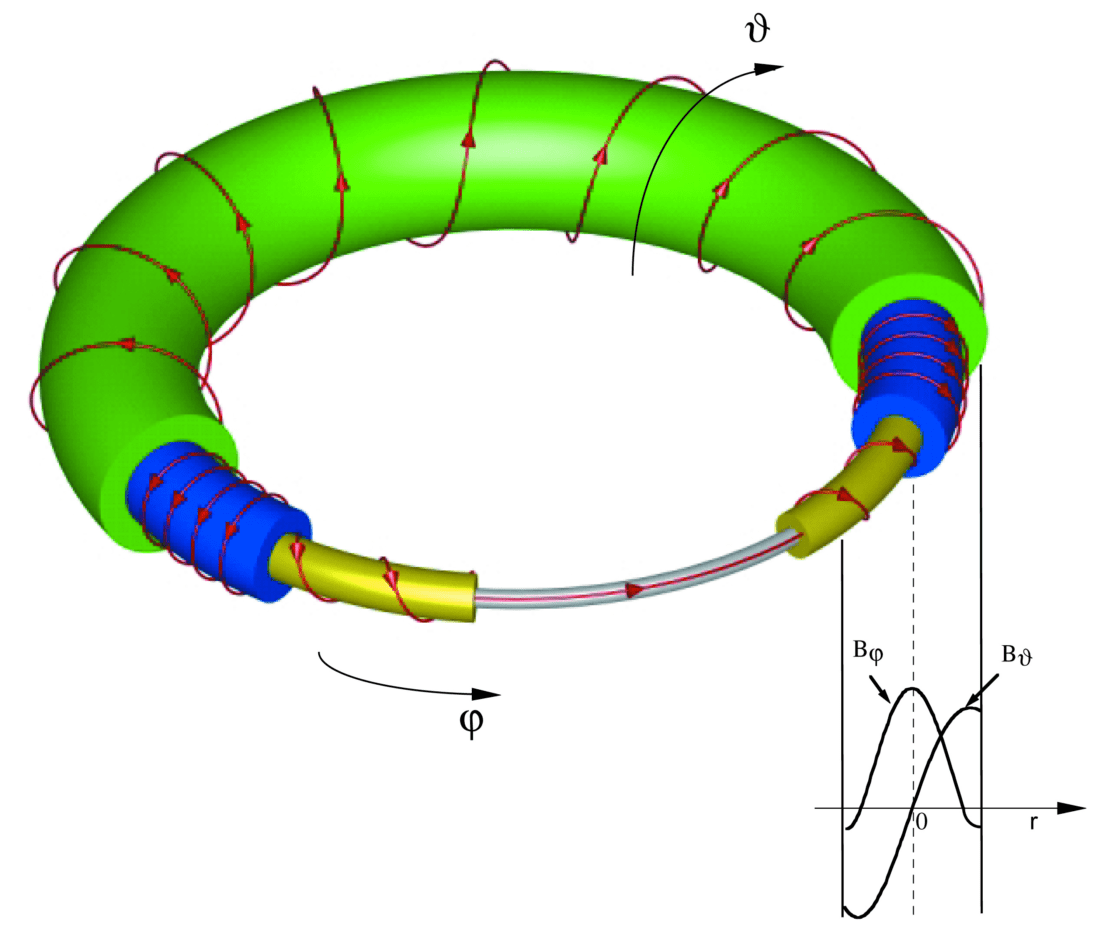
The Reversed Field Pinch (RFP) configuration is characterized by the fact that the toroidal magnetic field at the edge of the plasma is directed away from the centre. This type of magnetic confinement is used in some experimental machines for the study of plasma physics such as RFX-mod2.
The main advantage of RFP is the lower magnetic field strength required for plasma confinement compared to Tokamak configurations, where most of the magnetic field is created from the outside, and Stellarator configurations, where the magnetic field is generated entirely by external conductors.
In the RFP configuration, a large part of the magnetic field is instead generated by the plasma itself. This means that the external conductors of an RFP can be simpler, as they need to produce a magnetic field with lower intensity than the other configurations.
Furthermore, in an RFP, compared to a tokamak, a much higher current corresponds to the same central toroidal field, thus the ohmic effect heating is much greater. This in principle could allow thermonuclear temperatures to be reached without the need for additional heating, a great simplification and efficiency boost for a reactor.
The RFP plasma, when the current exceeds a certain threshold value, organizes itself spontaneously assuming the shape of a helix: in this condition the temperature is higher and the confinement more stable. This discovery, made in our laboratories, earned a prestigious scientific publication and a cover of Nature Physics in 2009.
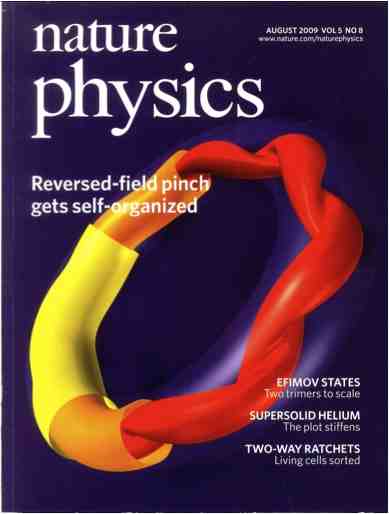
One or more of these helical deformations may be present in RFP plasmas. Up until the 90s only situations in which many helical deformations were simultaneously present, multiple helicity states, were observed. Since the year 2000 transitions to states in which a single helical deformation dominates over the others have been discovered, known as quasi single helicity states.
To obtain a field of this kind different types of magnets are used:
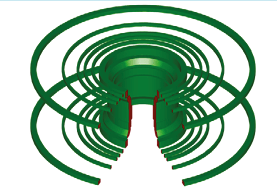
Magnetizing winding
This generates the poloidal field and induces the plasma current. The RFP plasma, like that of the Tokamak, is characterized by a toroidal plasma current: this current is generated by induction, as in a transformer. The change in current in the primary circuit, called “magnetizing”, induces a current in the plasma. In the RFX-mod experiment, a plasma current of 2 MA was reached.
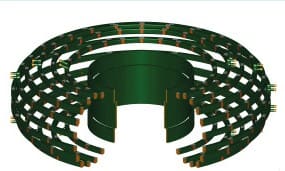
Field Shaping (FS) Winding
This is the primary winding together with the stabilizing shell, and has the purpose of controlling the plasma equilibrium.
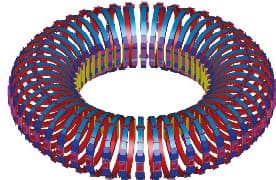
Toroidal winding
The toroidal winding provides the toroidal component of the magnetic field
The induced current heats the plasma due to Ohm’s law of electrical resistance. Unlike the Tokamak which instead requires auxiliary heating, including the injection of energetic particles, this “ohmic heating” is the only source of heating of the RFP.
In addition to the external conductors, the RFP configuration requires a perfectly conductive shell. This structure is defined as a “stabilizing body” because in its absence the plasma develops violent magnetic field instabilities which destroy the configuration and can no longer confine the plasma.
The stabilization of the RFP plasma occurs thanks to eddy currents, which are currents induced by a variation of the magnetic field due to the movement of the plasma. This current tends to push the plasma away and therefore helps to hold it in place. Eddy currents can flow along the stabilizing body, but since no material is perfectly conductive, these currents decay after a certain period of time and the stabilizing function of the body is lost.
To overcome this fundamental problem, special conductors in which currents flow, such as saddle coils, are required to perform the same function as eddy currents.
In 2005, results on the RFX-mod machine showed that controlled eddy currents can be generated with saddle coils inserted in a feedback system. The feedback system was inspired by technology developed for submarine sonar.
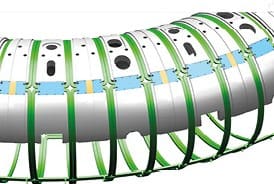
The active coil system
RFX-mod has been equipped with an advanced system for MHD feedback control. The system is based on 192 saddle coils, which cover the entire vacuum chamber. The coils are arranged in 48 toroidal positions, with 4 poloidal coils each. They are driven independently by the individual power supplies and can produce a radial magnetic field of up to 50 mT dc and 3.5 mT at 100 Hz.
The plasma currents form typical deformations that lead it to assume a helical position. When more deformations are present they form constructive or destructive interference patterns. If the energy losses are concentrated in a single point, they cause the first wall of the machine that contains the plasma to be under stress. With the active coil system we try to overcome this problem by preventing the plasma from developing deformations harmful to the experiment.

The ohmic support of the RFP configuration has been a sizeable theoretical problem addressed from the beginning and has important similarities with astrophysical plasmas. The astrophysicist Lodewijk Woltjer, in 1958, showed that fusion plasmas characterized by the inversion of the magnetic field are also found in the cosmos, as in the Solar Corona.

The mechanism of magnetic field inversion can be illustrated relatively easily using a simplified model.
Imagine inserting a current-carrying wire into a metal cylinder which is conserves the magnetic field flux. The wire is in unstable equilibrium, i.e. it is easy for it to twist, forming a helix. The magnetic field along the axis, which represents the toroidal field (Bt), increases in the empty space inside the helix.
Outside the helix, since the total flux is conserved, the magnetic field decreases. If the radius of the helix increases, eventually a stable equilibrium situation is reached, in which the axial field at the edge is reversed.
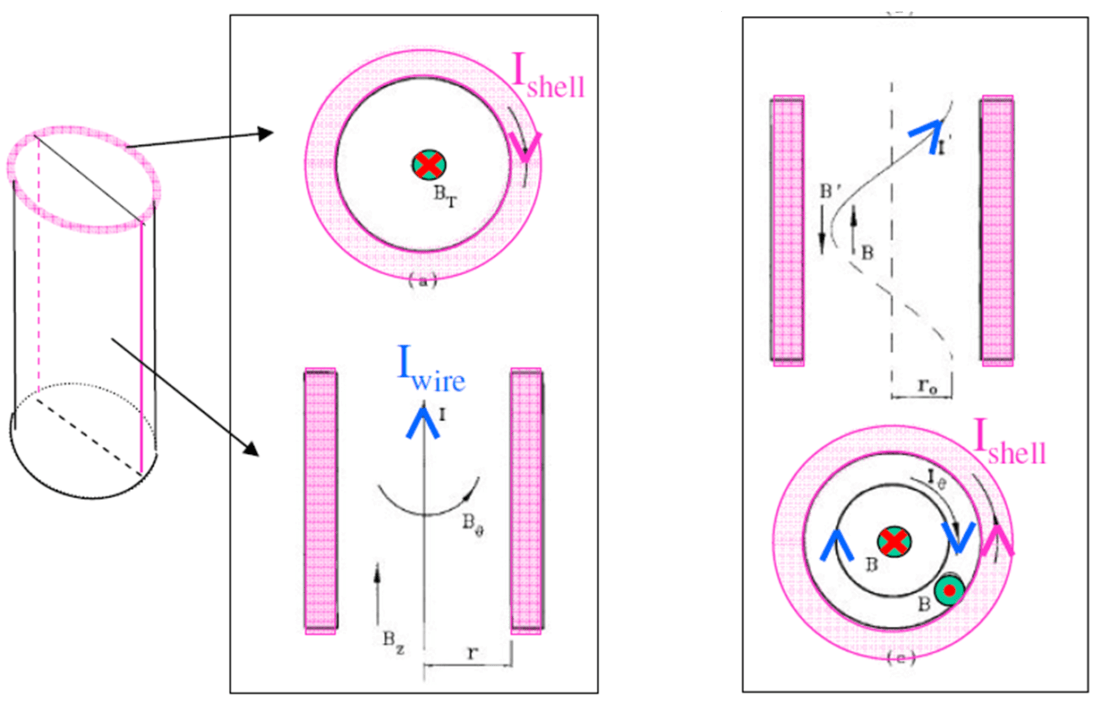
DF Escande, S Cappello, F D’Angelo, P Martin, S Ortolani and RPaccagnella (2000) Single helicity: a new paradigm for the reversed field pinch
DOI 10.1088/0741-3335/42/12B/319
L. Marrelli, P. Martin, M.E. Puiatti, J.S. Sarff, B.E. Chapman, J.R. Drake, D.F. Escande, S. Masamune (2021) The reversed field pinch. Nuclear Fusion, Vol 61, Pag 023001. DOI:https://dx.doi.org/10.1088/1741-4326/abc06c
R. Lorenzini, E. Martines, P. Piovesan, D. Terranova, P. Zanca, M. Zuin, A. Alfier, D. Bonfiglio, F. Bonomo, A. Canton, S. Cappello, L. Carraro, R. Cavazzana, D. F. Escande, A. Fassina, P. Franz,
M. Gobbin, P. Innocente, L. Marrelli, R. Pasqualotto, M. E. Puiatti, M. Spolaore, M. Valisa, N. Vianello, P. Martin (2009) Self-organized helical equilibria as a new paradigm for ohmically heated fusion plasmas. Nature Physics, Vol. 5, Pag. 570-574.| DOI: 10.1038/NPHYS1308